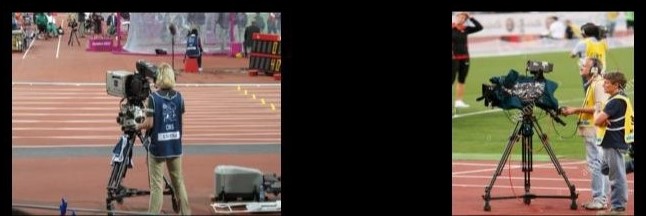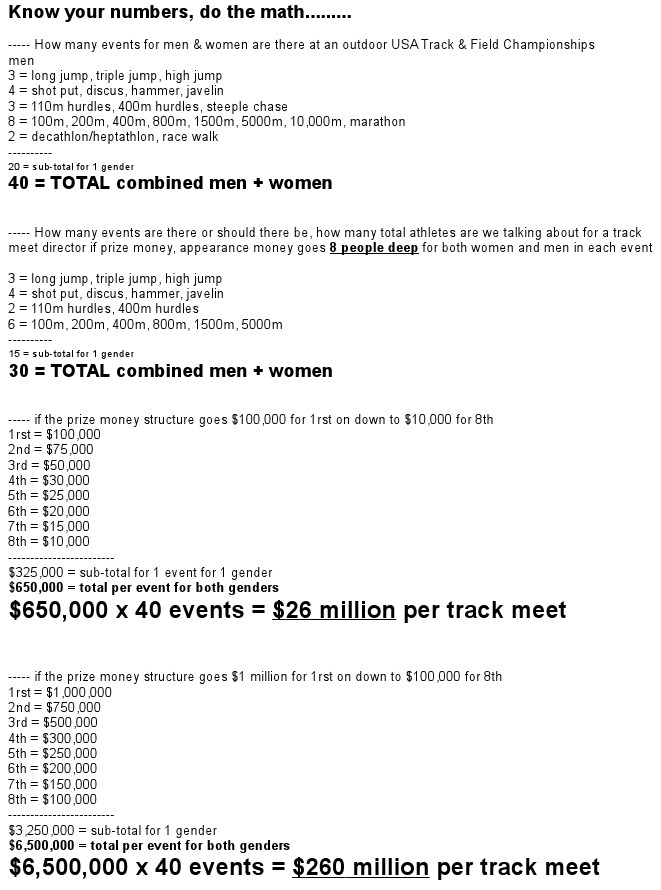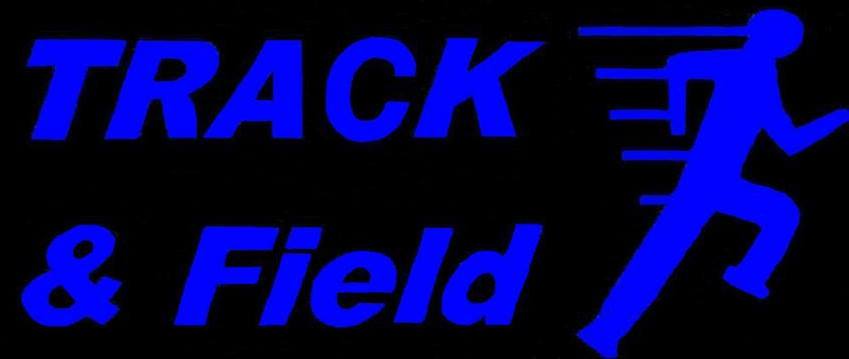Professional
Track & Field
TV Schedule
—————-
.

2024
—– May — time & channel info coming — Diamond League [Doha, Qatar]
—– May — time & channel info coming — Diamond League [Rabat, Morocco]
—– June — time & channel info coming — Diamond League, Prefontaine Classic [Eugene, Oregon]
—– June — time & channel info coming — USA Track & Field Championships [Eugene, Oregon]
—– June — time & channel info coming — Diamond League [Paris France]
—- June — time & channel info coming — New York Grand Prix [New York, New York]
—- June — time & channel info coming — Diamond League [Florence, Italy]
—– June — time & channel info coming — Diamond League [Oslo, Norway]
–— July — time & channel info coming — Diamond League [Lausanne, Switzerland]
—– July — time & channel info coming — Diamond League [Stockholm, Sweden]
—– July — time & channel info coming — Diamond League [Silesia, Poland]
—– July — time & channel info coming — Diamond League [Monte Carlo, Monaco]
—– July — time & channel info coming — Diamond League [London, United Kingdom]
—– July — time & channel info coming — Diamond League [Zurich, Switzerland]
–— August — time & channel info coming — Diamond League [Shenzhen, China]
—– August — time & channel info coming — Diamond League [Brussels, Belgium]
.
Track & Field Weekly……Fridays on OLY Channel
The news and interviews TV show for
global professional Track & Field
.

.
.
.
.
The Business Called
Track & Field
.
A broad idea of some of the kinds of numbers we, as a sport, can aspire to, can work toward. Not just for our major championships but for our televised major invitational track meets as well. Athletes, coaches, administrators, its important to know some numbers so as to know where we are all looking to go and grow.
.

.

.
.
Track & Field Sport promotions, Sport marketing, Sport advertising……
Track & Field in the United States got left behind in the 1970’s as the NFL, NBA, and MLB discovered sport promotions and sport marketing while we missed that boat and had the ball & chain of the Olympic Games amateurism rules hanging around our sport’s neck. Now as a professional sport looking to move itself forward, we would do well to recognize that the Olympic Games is not our friend. Its time for the sport to separate from the International Olympic Committee. Its time and the sport is ready. Our World Track & Field Championships is our sport’s future.
At some point we should consider a move to holding the World Championships every year instead of every 2 years. In the United States we’re in need of standardizing our majors into 2 to 3 hour-ish track meets at all levels including high school, college, and professional, with all events [including throws and jumps] held inside the stadium. And due to the structure of our sport, we would do well to standardize the presentation of all championship track meets, including high school, NCAA, USA Track & Field, and the World Track & Field Championships in a format that separates qualifying rounds for -all- events, from championship finals. We must present a day[s] of a finals only format for Championships.
In the United States, we may need to go a few years where the wealthier track athletes become willing to spend $10,000 to $20,000 on self-promotional TV commercials in their home city, especially in small TV market cities. Some of the various professional groups of track athletes should consider pooling their money for this effort. Visibility, visibility, visibility is the base and foundation of sport promotions. The visibility one creates for oneself is visibility for the sport as well.
Basics Of Track & Field Sport Promotions
— contribute to the visibility of Track & Field inside the United States
— seek and promote track meets that serve track fans…..track meets that serve track fans cultivate a track community by creating effective channels of access to the sport
— contribute a high performance level, something for people to see when they watch a track meet in person or on TV……which helps put on track meets that serve track fans
— promote the sport by using political campaign types of tactics. Give away sport identity and affiliation stuff for free [buttons, bumper stickers, t-shirts, key chains].
— There exists no way to promote Track & Field in the United States by racing in Europe if those meets are -not- aired on widely available, mainstream TV channels on U.S. televisions.
— Create and maintain expectations, familiarity, and recognizability.….thus, no constant changing of track meet schedules, no constant changing of colors or designs of uniforms each year, no sunglasses or anything that covers one’s face during races.
— print media drives television media. Get fans to track meets….then, get the track meets on television.
— focus all efforts -first- within our circle of influence [people that are already within the sport]….then, focus on expanding that circle of influence.
— create a consistent message. Never change it. One message repeated often, gets heard.
TheETG Track & Field Promotions Project —– https://theetgtrackclub.com/documents/TheETGTrackPromotionmasterofsport.pdf
TheETG “This Is Track & Field” document —– https://theetgtrackclub.com/documents/TheETGThisIsTrack&Fieldmasterofsport.pdf
.
Track & Field coverage on TV. It is always appreciated by track fans when TV networks decide to abandon the 2 to 3 decades long approach of…”appeal to the average viewer”….that has been kicking our sport in the crotch in TV coverage for so many years.People will watch if there’s something to watch. When you try to appeal to everybody you end up being appealing to nobody.When you direct your coverage towards the fan, as is done with the NFL, NBA, Major League Baseball, NHL, things tend to go way better as Premiere League soccer is also demonstrating in their broadcasts into the United States.Don’t wait for vision-less people to say its possible. Make it happen and drive a big bandwagon.
Sport Promotions Outcome Goals --- increase the number of butts in the seats at major track meets --- increase quality of TV coverage of major track meets --- increase viewership of major track meets.
Mechanisms Of Goal Achievement --- visibility of the sport --- visibility of athletes --- performance level at major track meets --- presentation of major track meets
.
.
Format of major championship track & field meets…..NCAA Championship, USA Championship, World Championship
Track meet presentation. The in-person experience and the televised product. Improving and simplifying the presentation of our sport, particularly at the championship level is necessary over the long term as our sport continues to grow in quality and depth at the professional level. Over the long term, as much as we’ve resisted in the past, at some point we’re gonna have to move to a format for our major championship track & field meets where we place the qualifying rounds together as a group as if they’re part of a separate track meet, held earlier in the week. That, being followed by the finals on a Saturday and/or Sunday, held as if its a separate, stand alone track meet.
I’m proposing a quarter-final, semi-final, and final type of format where 1 or 2 days is designated for finals only. The quarter-final and semi-finals placed for all events in a Monday thru Thursday structure. Finals-only events such as the race walk, 10,000 meters and marathon could be spread across the weekend. Switching to a “finals-day” format provides opportunities for broadcasters to expand and deepen their coverage. And switching to this type of format inherently provides our sport with an opportunity to conduct our championship semi-final rounds as if they are a track meet unto themselves. Set apart on their own day[s] earlier in the week, providing our sport with an additional high value product to sell for tickets, television rights, in-stadium advertising, etc. And obviously in this day and age the rights to the quarter-final rounds can be sold to TV or online broadcasters.
Switching to the separate day format for qualifying rounds, semi-final, and finals provides for a better track fan experience, particularly for ticket purchasers. The track fans that purchase tickets will have a far better understanding of the product they are buying. Those that purchase tickets for finals will know that they don’t have to sit through qualifying rounds of some events, waiting to get to see the finals they are really there to see. Low budget fans can more easily choose a “semi-finals day” ticket and know that they’re still getting to see a high value product.
This format provides athletes and coaches an easier way to plan ahead for championship meets in every area from budgets, to tapering, to race day event prep. This format also allows athletes that are participating in more than one non-relay event to have days where they don’t have a final of one event followed by the opening round of another. They can get all the qualifying rounds out of the way, have a day off, then focus solely on their event finals.
High schools and colleges in the United States should also consider moving to this type of format.
In short, at some point its gonna be necessary for us as a sport to move away from the current model that scatters finals and qualifying rounds across several days to 2 weeks, forcing fans, TV viewers, and broadcasters to be experts at schedule reading to know which finals are happening on any given day. We have an opportunity present our sport in a more logical, easier to follow manner. We should fully embrace that opportunity.
—————————————–
.
Time for Track & Field to leave the Olympic Games
Its been a decade or so since some in our sport, quite wisely in my view, started discussing the subject of making our World Track & Field Championships a stand-alone focus of the sport. Doing so by making a formal separation from the Olympic Games. Achieving this by limiting participation of Track & Field athletes in the Olympics to athletes under 20 or 22 years of age.
Perhaps several issues with the Olympic Games is the universe telling us to get on with it.
Too expensive to host. Too expensive to attend. Ticket prices out of reach of the average citizen of the host country. Fewer country’s making serious bids.
Expensive venues sitting idle after the Games are over.
In the last 50 years the Olympic Games has been a blessing and a curse for our sport. The world stage every 4 years was the blessing. The rules of amateurism and branding issues were the curse. And in the United States in the 1970s when the NFL, NBA, and Major League Baseball were reaching escape velocity via sport promotions, branding, and athlete pay, we in Track & Field were stuck with the Olympics as a ball-and-chain around our neck. Branded in the public’s mind as a once every 4 years sport. All narratives being that any athlete training must be training for “the Olympics”, in the process of being an “Olympic hopeful”. So attached to the Olympic Games were we that we didn’t even have a World Championship.
We have a World Track & Field Championships. Even the first one in 1983 was worthy of being branded as -the- best track meet on earth. At some point we’re probably gonna have to end our codependent relationship with the International Olympic Committee and the Olympic Games. To be a stand-alone sport with a stand-alone championship. Maybe this is a good time to assert the World Championships, an event we control, to be the sole focus and stand-alone Championship at the top of our sport.
—————————————–
.
Qualifying Times For Championship Meet Medals
The men’s 1500m and the so-called “strategic race”, also known as…..”jog 3 laps and sprint like a mad man”.
Medals at elite championships should be earned via elite level performances.
A certain type of consistent behavior across a period of years in the men’s hurdles contributed to forcing the creation of the “no false start” rule for everybody across all running events. Given the consistent behavior related to the “strategic race” in the 1500m, perhaps its time now for a “no medals” rule. Maybe its time to set a minimum qualifying time for medals as well.
In the 1500m folks getting on the podium at a World Championships or other major championship having run the time of a high schooler or young college athlete. The concept of training hard, getting fit, then showing up on race day and treating the track like its a dice table in Las Vegas. Training hard getting fit, then setting it all off to the side, outta the way so one can jog most of the race and try to outkick everybody.
The institutional memory of top American milers, so many left at home to watch the World Championships or other major championships on TV after running a fast time earlier in the season then rolling the dice, treating the track in the final at the USA Track & Field Championships like a dice table in Las Vegas, finishing 4th or worse as a result. Unwilling to just attempt to run up to their fitness level and embrace the outcome of that.
The 1500m all but demands a no medals rule. Anything slower than the cut-off time and all you get is a handshake and a pat on the back. No medals. In the final, if you run slower than whatever time was #8 or #10 on the world list in the previous year then to you we say congrats on winning or placing but no medal for you. Sorry, not sorry.
Medals at elite championships should be earned via elite level performances.
.
.
.
TheETG
— Annual —
Track & Field Meet Schedule
.

.
TheETG Annual Track & Field Meet Schedule is intended to provide a somewhat stable, predictable schedule for TheETG athletes, track fans, and media. It helps to address the issues of “follow-ability” and recognizability in a sport where traditionally athletes have had ever-changing race schedules, ever-changing uniforms, hair styles, and face coverings [a.k.a. sunglasses] that sabotage long term sport promotions. TheETG Annual Track & Field Meet Schedule is also intended to help promote the track meets on the schedule.
.
1 —– New Balance Indoor Grand Prix
2 —– Texas Invitational [Austin, Texas]
3 —– Prefontaine Classic [Eugene, Oregon]
4 —– USA Track & Field Championships
.
.

